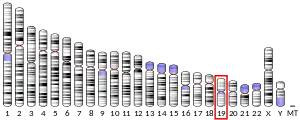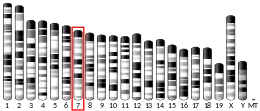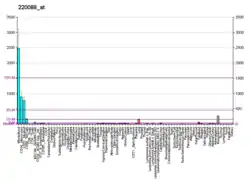C5a receptor
The C5a receptor also known as complement component 5a receptor 1 (C5AR1) or CD88 (Cluster of Differentiation 88) is a G protein-coupled receptor for C5a. It functions as a complement receptor.[5] C5a receptor modulates inflammatory responses, obesity, development and cancers.[6][7][8]

C5a receptor structure and its residues possessing role in ligand binding or signaling.
Cells
The C5a receptor is expressed on:[9]
- Granulocytes
- Monocytes
- Dendritic cells
- Hepatoma-derived cell line HepG2
- Astrocytes
- Microglia
Agonist and antagonists
Potent and selective agonist and antagonists for C5aR have been developed.[10][11][12][13]
See also
- Complement component 5a for binding mechanism
References
- GRCh38: Ensembl release 89: ENSG00000197405 - Ensembl, May 2017
- GRCm38: Ensembl release 89: ENSMUSG00000049130 - Ensembl, May 2017
- "Human PubMed Reference:". National Center for Biotechnology Information, U.S. National Library of Medicine.
- "Mouse PubMed Reference:". National Center for Biotechnology Information, U.S. National Library of Medicine.
- Gerard C, Gerard NP (1994). "C5A anaphylatoxin and its seven transmembrane-segment receptor". Annual Review of Immunology. 12: 775–808. doi:10.1146/annurev.iy.12.040194.004015. PMID 8011297.
- Brennan FH, Gordon R, Lao HW, Biggins PJ, Taylor SM, Franklin RJ, Woodruff TM, Ruitenberg MJ (April 2015). "The Complement Receptor C5aR Controls Acute Inflammation and Astrogliosis following Spinal Cord Injury". The Journal of Neuroscience. 35 (16): 6517–31. doi:10.1523/JNEUROSCI.5218-14.2015. PMC 6605214. PMID 25904802.
- Lim J, Iyer A, Suen JY, Seow V, Reid RC, Brown L, Fairlie DP (February 2013). "C5aR and C3aR antagonists each inhibit diet-induced obesity, metabolic dysfunction, and adipocyte and macrophage signaling". FASEB Journal. 27 (2): 822–31. doi:10.1096/fj.12-220582. PMID 23118029. S2CID 25562647.
- Markiewski MM, DeAngelis RA, Benencia F, Ricklin-Lichtsteiner SK, Koutoulaki A, Gerard C, Coukos G, Lambris JD (November 2008). "Modulation of the antitumor immune response by complement". Nature Immunology. 9 (11): 1225–35. doi:10.1038/ni.1655. PMC 2678913. PMID 18820683.
- Klos A, Wende E, Wareham KJ, Monk PN (January 2013). "International Union of Basic and Clinical Pharmacology. [corrected]. LXXXVII. Complement peptide C5a, C4a, and C3a receptors". Pharmacological Reviews. 65 (1): 500–43. doi:10.1124/pr.111.005223. PMID 23383423.
- Wong AK, Finch AM, Pierens GK, Craik DJ, Taylor SM, Fairlie DP (August 1998). "Small molecular probes for G-protein-coupled C5a receptors: conformationally constrained antagonists derived from the C terminus of the human plasma protein C5a". Journal of Medicinal Chemistry. 41 (18): 3417–25. doi:10.1021/jm9800651. PMID 9719594.
- Gong Y, Barbay JK, Buntinx M, Li J, Wauwe JV, Claes C, Lommen GV, Hornby PJ, He W (July 2008). "Design and optimization of aniline-substituted tetrahydroquinoline C5a receptor antagonists". Bioorganic & Medicinal Chemistry Letters. 18 (14): 3852–5. doi:10.1016/j.bmcl.2008.06.059. PMID 18595693.
- Sumichika H, Sakata K, Sato N, Takeshita S, Ishibuchi S, Nakamura M, Kamahori T, Ehara S, Itoh K, Ohtsuka T, Ohbora T, Mishina T, Komatsu H, Naka Y (December 2002). "Identification of a potent and orally active non-peptide C5a receptor antagonist". The Journal of Biological Chemistry. 277 (51): 49403–7. doi:10.1074/jbc.M209672200. PMID 12384495.
- Seow V, Lim J, Cotterell AJ, Yau MK, Xu W, Lohman RJ, Kok WM, Stoermer MJ, Sweet MJ, Reid RC, Suen JY, Fairlie DP (April 2016). "Receptor residence time trumps drug-likeness and oral bioavailability in determining efficacy of complement C5a antagonists". Scientific Reports. 6 (1): 24575. doi:10.1038/srep24575. PMC 4837355. PMID 27094554.
Further reading
- Sengeløv H (1996). "Complement receptors in neutrophils". Critical Reviews in Immunology. 15 (2): 107–31. doi:10.1615/critrevimmunol.v15.i2.10. PMID 8573284.
- Beil WJ, Schulz M, Wefelmeyer U (July 2000). "Mast cell granule composition and tissue location--a close correlation". Histology and Histopathology. 15 (3): 937–46. PMID 10963136.
- Yamamoto T (January 2007). "Roles of the ribosomal protein S19 dimer and the C5a receptor in pathophysiological functions of phagocytic leukocytes". Pathology International. 57 (1): 1–11. doi:10.1111/j.1440-1827.2007.02049.x. PMID 17199736.
- Bao L, Gerard NP, Eddy RL, Shows TB, Gerard C (June 1992). "Mapping of genes for the human C5a receptor (C5AR), human FMLP receptor (FPR), and two FMLP receptor homologue orphan receptors (FPRH1, FPRH2) to chromosome 19". Genomics. 13 (2): 437–40. doi:10.1016/0888-7543(92)90265-T. PMID 1612600.
- Gerard NP, Gerard C (February 1991). "The chemotactic receptor for human C5a anaphylatoxin". Nature. 349 (6310): 614–7. doi:10.1038/349614a0. PMID 1847994. S2CID 4338594.
- Boulay F, Mery L, Tardif M, Brouchon L, Vignais P (March 1991). "Expression cloning of a receptor for C5a anaphylatoxin on differentiated HL-60 cells". Biochemistry. 30 (12): 2993–9. doi:10.1021/bi00226a002. PMID 2007135.
- Wahl SM, Allen JB, Gartner S, Orenstein JM, Popovic M, Chenoweth DE, Arthur LO, Farrar WL, Wahl LM (May 1989). "HIV-1 and its envelope glycoprotein down-regulate chemotactic ligand receptors and chemotactic function of peripheral blood monocytes". Journal of Immunology. 142 (10): 3553–9. PMID 2541200.
- Foreman KE, Vaporciyan AA, Bonish BK, Jones ML, Johnson KJ, Glovsky MM, Eddy SM, Ward PA (September 1994). "C5a-induced expression of P-selectin in endothelial cells". The Journal of Clinical Investigation. 94 (3): 1147–55. doi:10.1172/JCI117430. PMC 295185. PMID 7521884.
- Giannini E, Brouchon L, Boulay F (August 1995). "Identification of the major phosphorylation sites in human C5a anaphylatoxin receptor in vivo". The Journal of Biological Chemistry. 270 (32): 19166–72. doi:10.1074/jbc.270.32.19166. PMID 7642584.
- Buhl AM, Osawa S, Johnson GL (August 1995). "Mitogen-activated protein kinase activation requires two signal inputs from the human anaphylatoxin C5a receptor". The Journal of Biological Chemistry. 270 (34): 19828–32. doi:10.1074/jbc.270.34.19828. PMID 7649993.
- Wennogle LP, Conder L, Winter C, Braunwalder A, Vlattas S, Kramer R, Cioffi C, Hu SI (July 1994). "Stabilization of C5a receptor--G-protein interactions through ligand binding". Journal of Cellular Biochemistry. 55 (3): 380–8. doi:10.1002/jcb.240550316. PMID 7962171. S2CID 36216040.
- Gerard NP, Bao L, Xiao-Ping H, Eddy RL, Shows TB, Gerard C (February 1993). "Human chemotaxis receptor genes cluster at 19q13.3-13.4. Characterization of the human C5a receptor gene". Biochemistry. 32 (5): 1243–50. doi:10.1021/bi00056a007. PMID 8383526.
- Ames RS, Li Y, Sarau HM, Nuthulaganti P, Foley JJ, Ellis C, Zeng Z, Su K, Jurewicz AJ, Hertzberg RP, Bergsma DJ, Kumar C (August 1996). "Molecular cloning and characterization of the human anaphylatoxin C3a receptor". The Journal of Biological Chemistry. 271 (34): 20231–4. doi:10.1074/jbc.271.34.20231. PMID 8702752.
- Werfel T, Zwirner J, Oppermann M, Sieber A, Begemann G, Drommer W, Kapp A, Götze O (August 1996). "CD88 antibodies specifically bind to C5aR on dermal CD117+ and CD14+ cells and react with a desmosomal antigen in human skin". Journal of Immunology. 157 (4): 1729–35. PMID 8759762.
- Höpken UE, Lu B, Gerard NP, Gerard C (September 1996). "The C5a chemoattractant receptor mediates mucosal defence to infection". Nature. 383 (6595): 86–9. doi:10.1038/383086a0. PMID 8779720. S2CID 4346934.
- Chen Z, Zhang X, Gonnella NC, Pellas TC, Boyar WC, Ni F (April 1998). "Residues 21-30 within the extracellular N-terminal region of the C5a receptor represent a binding domain for the C5a anaphylatoxin". The Journal of Biological Chemistry. 273 (17): 10411–9. doi:10.1074/jbc.273.17.10411. PMID 9553099.
- Floreani AA, Heires AJ, Welniak LA, Miller-Lindholm A, Clark-Pierce L, Rennard SI, Morgan EL, Sanderson SD (May 1998). "Expression of receptors for C5a anaphylatoxin (CD88) on human bronchial epithelial cells: enhancement of C5a-mediated release of IL-8 upon exposure to cigarette smoke". Journal of Immunology. 160 (10): 5073–81. PMID 9590258.
- Ottonello L, Corcione A, Tortolina G, Airoldi I, Albesiano E, Favre A, D'Agostino R, Malavasi F, Pistoia V, Dallegri F (June 1999). "rC5a directs the in vitro migration of human memory and naive tonsillar B lymphocytes: implications for B cell trafficking in secondary lymphoid tissues". Journal of Immunology. 162 (11): 6510–7. PMID 10352266.
- Kohleisen B, Shumay E, Sutter G, Foerster R, Brack-Werner R, Nuesse M, Erfle V (December 1999). "Stable expression of HIV-1 Nef induces changes in growth properties and activation state of human astrocytes". AIDS. 13 (17): 2331–41. doi:10.1097/00002030-199912030-00004. PMID 10597774.
- Monk PN, Scola AM, Madala P, Fairlie DP (October 2007). "Function, structure and therapeutic potential of complement C5a receptors". British Journal of Pharmacology. 152 (4): 429–48. doi:10.1038/sj.bjp.0707332. PMC 2050825. PMID 17603557.
External links
- "Anaphylatoxin Receptors: C5a". IUPHAR Database of Receptors and Ion Channels. International Union of Basic and Clinical Pharmacology.
- C5a+receptors at the US National Library of Medicine Medical Subject Headings (MeSH)
- Human C5AR1 genome location and C5AR1 gene details page in the UCSC Genome Browser.
- Overview of all the structural information available in the PDB for UniProt: P21730 (C5a anaphylatoxin chemotactic receptor 1) at the PDBe-KB.
This article is issued from Wikipedia. The text is licensed under Creative Commons - Attribution - Sharealike. Additional terms may apply for the media files.




